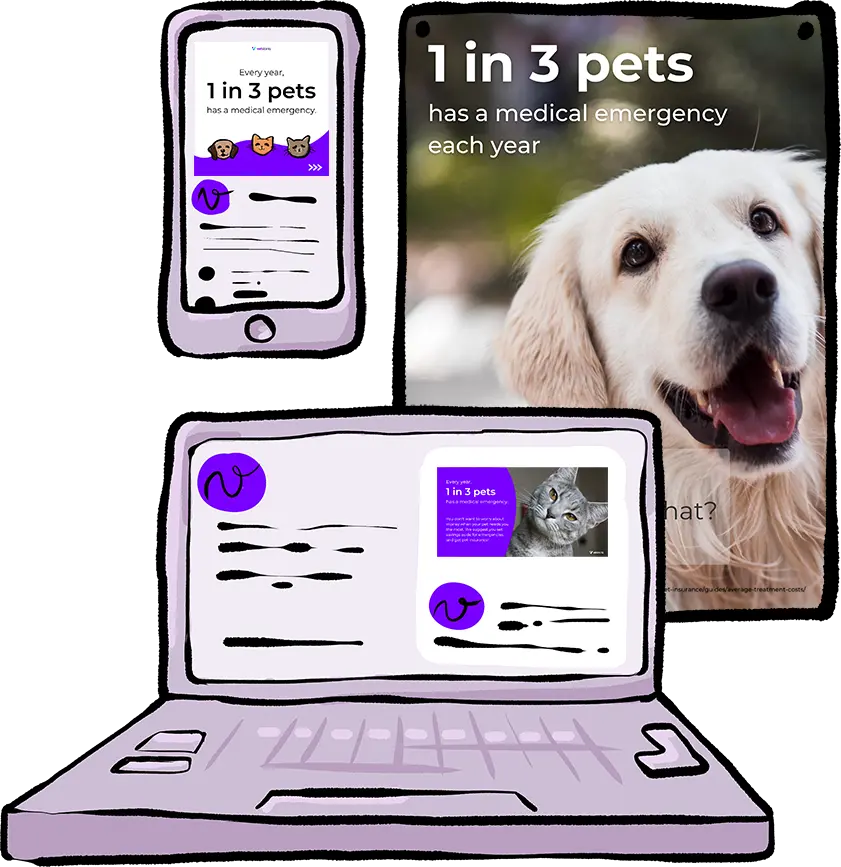Teach pet owners about Pet Insurance
Every year, one in three pets has a veterinary emergency. Use these assets to educate pet owners on the importance of pet insurance, so they can cover their pet’s medical expenses without straining their finances. To save you even more time, we’ve included a pre-written email, and suggested captions for each of our social media templates!
Download our ready-to-use social assets:
Or brand the content for your clinic in 3 easy steps

Choose the pack you want, and open the clickable template links

Export the design as it is, or add your logo, brand colors, and update the text

Download the design for your digital channels, or print physical copies!
Customize the assets as you like:
What information is included in the Pet Insurance pack?
One in three pets have a veterinary emergency every year.
- An out-of-hours consult costs £200 on average before treatment or diagnostics.
- Did your dog swallow something it really shouldn’t? Foreign body removal can cost up to £3,120.
- Did your cat develop diabetes? You can expect to pay £120 a month for medicine for the rest of their life.
Can’t afford all that?
Pet insurance ensures you’ll be able to take care of your pet’s medical expenses without straining your finances.
When your pet is experiencing an emergency, money is the last thing you want to worry about.
Get it before you need it: your pet (and wallet) will thank you.
Coverage depends on your plan, but the following are excluded from most pet insurance plans:
- Pre-existing conditions (illnesses or injuries that get diagnosed before you get an insurance policy). That’s why it’s a good idea to ensure your pet while your pet is young and healthy.
- Routine appointments, such as vaccinations, parasite prevention, and dentals. Getting our Care Plan will help you with those expenses.
- Anything else excluded by your insurer. Read the terms and conditions carefully to ensure you have the coverage you need.
With most insurers, you’ll still need to cover the costs up-front in the clinic, and they’ll reimburse you afterward.
Premium – the recurring amount of money you pay for your pet insurance.
Excess – the amount of money you pay out before pet insurance kicks in. (If your excess is £20, and the vet bill is £100 – insurance will pay £80.)
Per incident excess – You’ll cover this excess every time you go to the vet.
Per year excess – You’ll cover this excess once every year, and pet insurance will kick in immediately for every incident after that.
Co-pay – a percentage of the veterinary costs you have to cover in addition to your excess. This usually applies to older pets.
Pre-existing condition – illness, injury or condition your pet had before you got the pet insurance policy. Each insurer defines this differently, so pay attention to your plan!
Waiting period – After you start paying for your new pet insurance policy, there will be a waiting period before they start covering expenses. Conditions that arise during this period are often treated as pre-existing conditions. The period and terms vary per insurer, and even between different ailments within the same policy. Some providers waive this time if you’re transferring from another pet insurer, so that you don’t have a gap in your coverage.
Lifetime insurance – Lifetime pet insurance is the gold standard of pet insurance. You’ll pay a recurring fee (usually monthly) and, in exchange, you’ll be covered for every veterinary expense up to a yearly amount. When the year is over, the amount will re-set, and you’ll be covered for the full amount again.
Lifetime pet insurance is best for owners of young pets with no pre-existing conditions, assuming you’ll renew it as-needed
Maximum benefit insurance – With Maximum Benefit insurance, you pay a recurring fee, and your pet is covered up to a monetary limit per condition. After that limit is reached, that condition is treated as pre-existing, and will no longer be covered.
For example: your dog is diagnosed with diabetes. Diabetes is covered up to 10.000$. Diabetes will be covered up until that 10000$ pot is depleted; then you’ll have to pay out-of-pocket. This financial buffer can give you time to prepare and adjust your budget according to the new condition.
Maximum benefit pet insurance is best for cost-conscious pet owners who still want full coverage, or owners who are looking to self-insure in the future.
Time-limited insurance – Time-limited pet insurance covers your pet up to a monetary limit, or a time limit (usually 12 months), whichever comes first. After that, each condition considered pre-existing and is no longer covered.
For example: your dog is diagnosed with diabetes. Diabetes is covered up to 10.000$, or 12 months. Even if in 12 months you haven’t spent 10000$ on diabetes treatments, the policy will expire and diabetes will no longer be covered.
Time-limited pet insurance is best for cost-conscious pet owners.
Accident insurance – Accident-only pet insurance only covers injuries, not illnesses. What is covered and how differs a lot between each provider, so always do your research!
Accident-only pet insurance is best suited to complement other plans, or to help pet owners that are otherwise self-insured.
Public Liability insurance – If your pet injures another pet, a person, causes an accident or damages property, and someone sues you in a court of law, this type of insurance will cover all costs. This includes damages, the other person’s hospital or vet bills, and all legal expenses associated with the case. Public liability insurance is usually only available to dogs, or large animals such as horses.
Public Liability pet insurance is best suited to complementing other policies.
Self-insurance – Self-funded pet insurance is when you prepare yourself to be able to meet the costs of all veterinary care by yourself, without the help of an outside underwriter. You create a savings account specifically for your pet, and withdraw from it when you need to.
It’s a good idea to start off with an amount saved already – if your pet has an emergency before you’ve saved up enough, you might end up going into debt to help them. To help keep this savings pot stocked, define a self-set excess and co-pay, and only withdraw the money a more traditional pet insurance plan would have covered.
Self-funded pet insurance is best suited to pet owners who can afford a veterinary emergency on their own. It may also suit owners of older pets who are not covered by lifetime insurance.
Pet insurance enables you to take care of your pet’s medical expenses without straining your finances.
Our pets are living longer, healthier lives – but the veterinary advancements that make this possible can quickly get expensive!
When your pet gets sick, you don’t want to worry about how you’re going to fund their treatment. With pet insurance, you don’t have to.
Our Content Pack Calendar has all the marketing assets you need for the rest of the year neatly mapped onto a calendar. It’s been specially designed to help you have the most engaging, productive, and profitable quarter yet for your veterinary clinic. Download 2023 Q4 calendar here!

Get Vetstoria Content Packs direct to your Inbox
Vetstoria users get more, with online booking links and QR codes

Build online booking campaigns
Create promotional booking campaigns (like free dental check ups!) that follow set scheduling rules based on your preferred dates, the availability of vets, and more!

Add trackable booking links and QR codes
Use trackable links in emails, SMS, social profiles, online ads and in the clinic to promote your campaigns and easily measure the results.

Use analytics to optimize results
See how many appointments and new clients are generated from each campaign, and learn which channels are most effective.

Build online booking campaigns
Create promotional booking campaigns that follow set scheduling rules based on preferred dates, the availability of vets, and more!

Add booking links to digital channels
Use trackable booking links in emails, SMS, social profiles, and online ads to promote your campaigns and easily measure the results.

Use analytics to optimize results
See how many appointments and new clients are generated from each campaign, and learn which channels are most effective.


